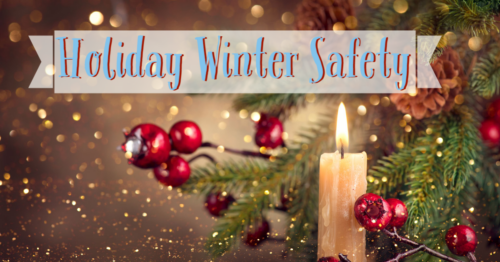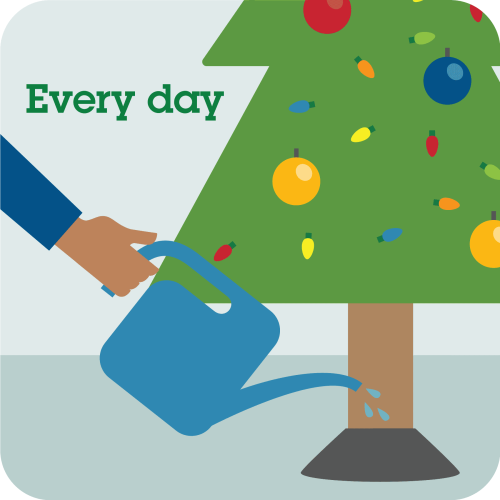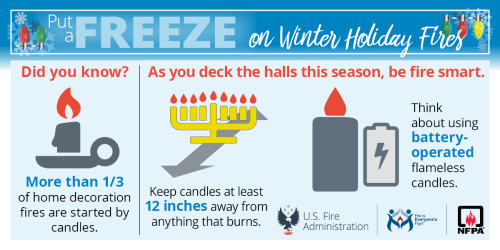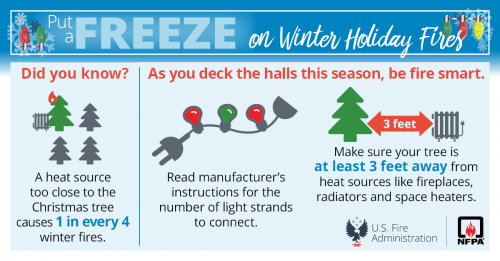
Festive celebrations, flickering lights and winter greens are hallmarks of the holiday season, but they also present fire risks that can quickly turn this festive time of year into a devastating one.
Holiday Cooking
In 2017, the three leading dates for home structure fires caused by cooking were: Thanksgiving, Christmas day and Christmas Eve. That’s why it’s important to know what you can do to help keep your friends and family safe while entertaining for the holidays.
Top 10 safety tips
- Stay in the kitchen when you are cooking on the stove top so you can keep an eye on the food.
- Stay in the home when cooking your turkey, and check on it frequently.
- Keep children away from the stove. The stove will be hot and kids should stay three feet away.
- Make sure kids stay away from hot food and liquids. The steam or splash from vegetables, gravy or coffee could cause serious burns.
- Keep knives out of the reach of children.
- Be sure electric cords from an electric knife, coffee maker, plate warmer or mixer are not dangling off the counter within easy reach of a child.
- Keep matches and utility lighters out of the reach of children — up high in a locked cabinet.
- Never leave children alone in room with a lit candle.
- Keep the floor clear so you don’t trip over kids, toys, pocketbooks or bags.
- Make sure your smoke alarms are working. Test them by pushing the test button.
Turkey Frying Safety Tips
- Keep outdoor fryers off decks, out of garages and a safe distance away from trees and other structures.
- Make sure the turkey is thawed and dry before cooking. Ice or water that mixes into the hot oil can cause flare-ups.
- Watch the weather. Never operate a fryer outdoors in the rain or snow.
- Place the fryer on a level surface, and avoid moving it once it’s in use.
- Leave 2 feet between the tank and the burner when using a propane-powered fryer.
- Follow the manufacturer’s instructions to avoid overfilling. Oil can ignite when it makes contact with the burner.
- Choose a smaller turkey for frying. A bird that’s 8 to 10 pounds is best; pass on turkeys over 12 pounds.
- Never leave fryers unattended.
- Purchase a fryer with temperature controls, and watch the oil temperature carefully. Cooking oil that is heated beyond its smoke point can catch fire. If you notice the oil is smoking, turn the fryer off.
- Turn off the burner before lowering the turkey into the oil. Once the turkey is submerged, turn the burner on.
- Wear goggles to shield your eyes, use oven mitts to protect your hands and arms and keep an “ABC” or grease-rated fire extinguisher close by. Do not use water or a garden hose on a fire related to turkey fryers.
- Skip the stuffing when frying turkey, and avoid water-based marinades.
- Keep children and pets away from the fryer at all times.
- Once finished, carefully remove the pot from the burner, place it on a level surface and cover to let the oil cool overnight before disposing.
- Opt for an oil-less fryer. This uses infrared heat, rather than oil, to cook the turkey.
Winter Holiday Fire Facts
- Electrical distribution or lighting equipment was involved in almost half of home Christmas tree fires.
- More than two of every five (42%) home Christmas tree fires started in the living room. Five percent were chimney or flue fires. One-fifth (21%) of the decoration fires started in the kitchen. Sixteen percent started in the living room, family room or den.
- Half (51%) of December home decoration fires were started by candles, compared to one-third (32%) in January to November.
- See more statistics on winter holiday fires.
Christmas Tree & Decoration Fires
Carefully decorating your home can help make your holidays safer. Between 2014-2018, U.S. fire departments responded to an average of 160 home fires that started with Christmas trees per year. U.S. fire departments responded to an estimated average of 770 home structure fires per year that began with decorations, excluding Christmas trees.
In the throes of holiday shopping and decorating? Check out the 9 Ways You’re a Holiday Decorating Disaster.
Christmas tree disposal
Christmas trees are combustible items that become increasingly flammable as they continue to dry out in your home. More than one-quarter (29%) of home fires that begin with Christmas trees occur in January. Although Christmas tree fires are not common, when they do occur they’re much more likely to be serious.
Candles
- On average, 21 home candle fires were reported each day between 2014-2018.
- Three of every five (60%) candle fires started when something that could burn, such as furniture, mattresses or bedding, curtains, or decorations, was too close to the candle.
- Candle fires peak in December. January ranked second. From January through November, 4% of home candle fires started with decorations. This jumped to 12% in December.
- Christmas is the peak day for candle fires with almost three times the daily average.

